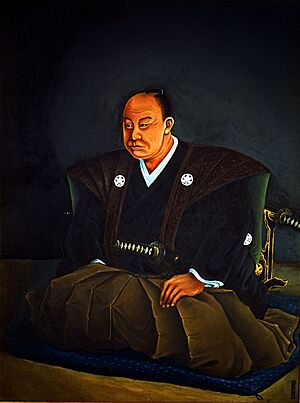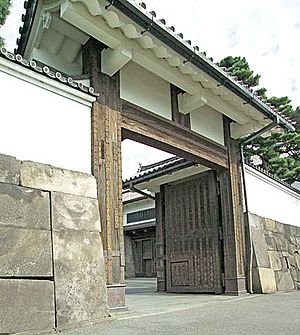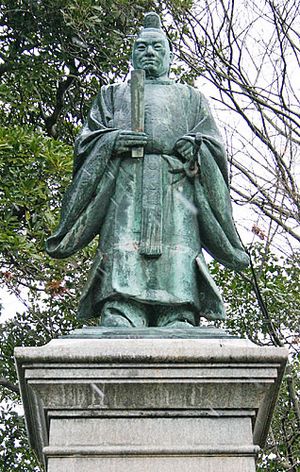Ii Naosuke facts for kids
Quick facts for kids
Ii Naosuke
|
|
|---|---|
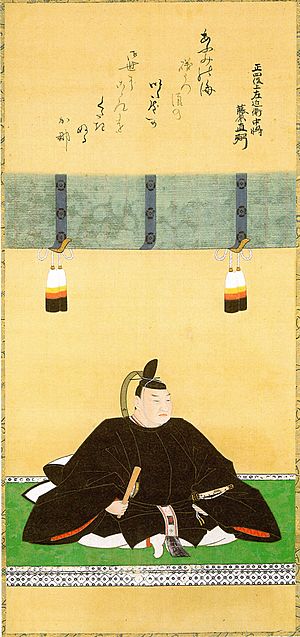 |
|
| Lord of Hikone | |
| In office 1858–1860 |
|
| Preceded by | Ii Naoaki |
| Succeeded by | Ii Naonori |
| Personal details | |
| Born | November 29, 1815 Edo, Japan |
| Died | March 24, 1860 (aged 44) Edo, Japan |
Ii Naosuke (井伊 直弼, November 29, 1815 – March 24, 1860) was a powerful Japanese leader during a very important time in Japan's history. He was a Daimyo, which means a powerful feudal lord, of the Hikone area from 1850 to 1860. He also held the high position of Tairō (Great Elder) for the Tokugawa shogunate. This was Japan's military government at the time.
Ii Naosuke is most famous for signing the Harris Treaty with the United States. This treaty opened Japanese ports for trade with American ships and sailors. It also gave special rights to American citizens in Japan. He was also very good at the Japanese tea ceremony. He even wrote books about it!
Under Ii Naosuke's leadership, the Tokugawa shogunate faced a big challenge. They had to choose a new leader because the current shōgun, Tokugawa Iesada, was sick and had no children. Ii Naosuke helped the shogunate regain some of its power for a short time. However, his actions made many people angry. He was assassinated in the Sakuradamon Incident on March 24, 1860. A group of samurai attacked him near Edo Castle.
Contents
Early Life and Rise to Power
Ii Naosuke was born on November 29, 1815. He was the 14th son of Ii Naonaka, who was the daimyō of Hikone. Because he had so many older brothers, Naosuke was not expected to become a powerful leader. Early in his life, he was sent to live in a Buddhist temple. He received only a small amount of money from his family.
Luckily for Ii, his older brothers either died or were adopted into other families. This meant that when his father passed away in 1850, Ii was called back from the temple. He then became the daimyō of Hikone. This made him eligible for a position in the bakufu. The bakufu was the council of the shōguns advisors.
Ii quickly became involved in national politics. In 1853, he suggested a plan for Japan's talks with U.S. Commodore Matthew C. Perry. Perry had come to Japan to open the country to the outside world. Ii knew that Japan was not strong enough to fight a foreign invasion. He argued that Japan should use its relationship with the Dutch to buy time. This time would allow Japan to build up its own military. Ii suggested that only the port of Nagasaki should be opened for foreign trade.
Becoming the Great Elder
In 1858, the shōgun Tokugawa Iesada chose Ii Naosuke to be the Tairō (Great Elder). This was a very important position, rarely filled. In fact, only three people had held this role in the 158 years before Ii. As Tairō, Ii Naosuke had great power and respect, second only to the shōgun. He wanted to bring back the power of the bakufu in Japan's decisions, both at home and with other countries.
Ii Naosuke believed that the Harris Treaty was good for Japan. This treaty had been discussed with the American envoy Townsend Harris. However, some powerful lords, like Tokugawa Nariaki, were against it. They tried to stop Ii from getting the Emperor's approval for the treaty.
The Americans were pressing Japan to sign the treaty. Ii decided not to risk making the Americans angry. On July 29, 1858, with the full support of the bakufu officials, Ii ordered the Harris Treaty to be signed. Soon after, he signed similar treaties with the Dutch, Russians, British, and French. Many people in Japan felt these treaties were unfair and hurt Japan's independence.
Choosing the Next Shōgun
The shōgun, Tokugawa Iesada, was in poor health. Some powerful lords wanted to choose Hitotsubashi Keiki as the next shōgun. Keiki was seen as a reformist leader. Ii Naosuke believed Japan needed strong leadership. However, he wanted the new leader to come from the traditional government system. The bakufu, led by Ii, supported the 12-year-old daimyō of Kii, Tokugawa Yoshitomi. They thought a young shōgun would be easier for them to guide.
To stop others from interfering, Ii decided that choosing the shōgun was a matter for the Tokugawa family alone. Neither the powerful lords nor the Emperor had the right to get involved. As the head advisor of the Tokugawa family, Ii could now choose the candidate he preferred. He ignored the lords who supported Hitotsubashi Keiki. Instead, he crowned Tokugawa Yoshitomi as the 14th Tokugawa shōgun. Yoshitomi later changed his name to Tokugawa Iemochi.
Ii's decision made him very unpopular with those who supported the Emperor. Especially angry were the samurai from the Mito Province. In late 1858, some reformists tried to get the Emperor to stop Ii. In response, Ii passed a special order. This allowed him to carry out the Ansei Purge.
During 1858 and 1859, Ii removed over 100 officials from the government and the Emperor's court. Eight of these officials were executed. The others were forced to retire. Ii also put Hitotsubashi Keiki and his family under house arrest. He removed anyone who disagreed with his handling of the Harris Treaty or the shōgun succession.
Marriage for Unity
In 1859, Ii Naosuke considered a plan called kōbu gattai. This idea was to bring the Emperor's court in Kyoto and the bakufu in Edo closer together. The goal was to strengthen the struggling shogunate by linking it with the Emperor's prestige. This plan involved a marriage between the shōgun and the Emperor's younger sister, Princess Kazunomiya.
Ii discussed this idea with the Imperial court. However, the plan was put on hold after Ii's Ansei purge removed some key supporters. The marriage between Tokugawa Iemochi and Princess Kazunomiya finally happened in 1861, after Ii Naosuke's death.
Death and Its Impact
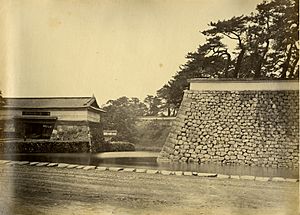
Ii's strict actions silenced many high-ranking officials. However, they did not stop lower-ranking samurai. Ii Naosuke's powerful rule as Tairō ended suddenly on March 24, 1860.
In the Sakuradamon Incident, Ii was attacked by 17 young samurai from the Mito Province. They cut him down right in front of one of the gates of the shōguns Edo Castle. Ii Naosuke was seen as a symbol of the bakufu's power. His assassination crushed any hopes for the shogunate to fully regain its strength. His attackers also left a note. It accused him of allowing Christianity to return to Japan, which was a controversial act at the time.
Ii Naosuke's death started a wave of violence across Japan. People began attacking other bakufu officials and their supporters. The shōgun and the bakufu were shocked by Ii's death. They did not announce it for several months. Instead, they pretended Ii was still alive. Then, they faked an illness and had him resign before announcing his death.
Ii's assassins were later given a general pardon by the bakufu. This set a precedent that actions could be forgiven if they were done for the good of the Emperor. News of this dramatic event traveled across the Pacific Ocean. On June 12, The New York Times reported that Japan's first diplomatic mission to the West had heard about what happened in Edo.
Legacy
After his death, people had very different opinions about Ii Naosuke. Even his enemies agreed that he was one of the most important political figures of the late Edo period. Because of his strict methods, he was often shown as a villain in writings from his time.
However, historians now often see Ii as a patriot. They believe he did everything for the good of Japan and the Emperor. They point to his 1853 plan regarding Commodore Perry. Ii realized Japan could not fight the Western powers. He suggested a policy of peaceful talks while Japan built up its military. This was the same policy the later Meiji government chose. Ii's decisions about foreign policy became very important for Japan well into the Meiji period.
For many years after his death, the Ii family faced disgrace. But recently, Ii's actions have been viewed more positively. Ii Naosuke is now recognized as one of the most important political figures in Japanese history. On October 7, 2009, Ii Naotake, a descendant of Naosuke, attended a memorial ceremony. This was a step towards reconciliation over the execution of Hashimoto Sanai during the Ansei Purge.
Ii Naosuke is buried in the temple of Gōtoku-ji, in Setagaya, Tokyo.
Images for kids
See also
 In Spanish: Ii Naosuke para niños
In Spanish: Ii Naosuke para niños


